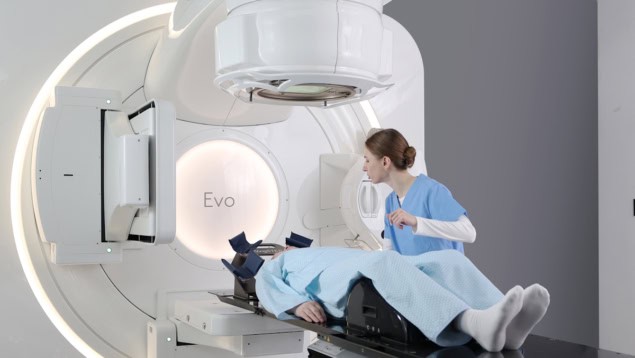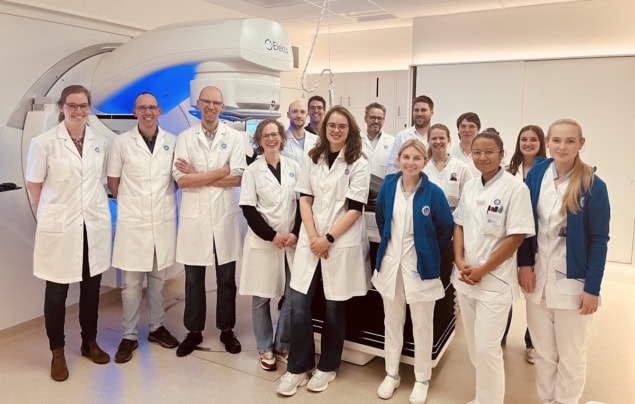Adaptive radiation therapy (ART) is a personalized cancer treatment in which a patient’s treatment plan can be updated throughout their radiotherapy course to account for any anatomical variations – either between fractions (offline ART) or immediately prior to dose delivery (online ART). Using high-fidelity images to enable precision tumour targeting, ART improves outcomes while reducing side effects by minimizing healthy tissue dose.
Elekta, the company behind the Unity MR-Linac, believes that in time, all radiation treatments will incorporate ART as standard. Towards this goal, it brings its broad knowledge base from the MR-Linac to the new Elekta Evo, a next-generation CT-Linac designed to improve access to ART. Evo incorporates AI-enhanced cone-beam CT (CBCT), known as Iris, to provide high-definition imaging, while its Elekta ONE Online software automates the entire workflow, including auto-contouring, plan adaptation and end-to-end quality assurance.
A world first
In February of this year, Matthias Lampe and his team at the private centre DTZ Radiotherapy in Berlin, Germany became the first in the world to treat patients with online ART (delivering daily plan updates while the patient is on the treatment couch) using Evo. “To provide proper tumour control you must be sure to hit the target – for that, you need online ART,” Lampe tells Physics World.
 <><>
<><>The ability to visualize and adapt to daily anatomy enables reduction of the planning target volume, increasing safety for nearby organs-at-risk (OARs). “It is highly beneficial for all treatments in the abdomen and pelvis,” says Lampe. “My patients with prostate cancer report hardly any side effects.”
Lampe selected Evo to exploit the full flexibility of its C-arm design. He notes that for the increasingly prevalent hypofractionated treatments, a C-arm configuration is essential. “CT-based treatment planning and AI contouring opened up a new world for radiation oncologists,” he explains. “When Elekta designed Evo, they enabled this in an achievable way with an extremely reliable machine. The C-arm linac is the primary workhorse in radiotherapy, so you have the best of everything.”
Time considerations
While online ART can take longer than conventional treatments, Evo’s use of automation and AI limits the additional time requirement to just five minutes – increasing the overall workflow from 12 to 17 minutes and remaining within the clinic’s standard time slots.
 <><>
<><>The workflow begins with patient positioning and CBCT imaging, with Evo’s AI-enhanced Iris imaging significantly improving image quality, crucial when performing ART. The radiation therapist then matches the cone-beam and planning CTs and performs any necessary couch shift.
Simultaneously, Elekta ONE Online performs AI auto-contouring of OARs, which are reviewed by the physician, and the target volume is copied in. The physicist then simulates the dose distribution on the new contours, followed by a plan review. “Then you can decide whether to adapt or not,” says Lampe. “This is an outstanding feature.” The final stage is treatment delivery and online dosimetry.
When DTZ Berlin first began clinical treatments with Evo, some of Lampe’s colleagues were apprehensive as they were attached to the conventional workflow. “But now, with CBCT providing the chance to see what will be treated, every doctor on my team has embraced the shift and wouldn’t go back,” he says.
The first treatments were for prostate cancer, a common indication that’s relatively easy to treat. “I also thought that if the Elekta ONE workflow struggled, I could contour this on my own in a minute,” says Lampe. “But this was never necessary, the process is very solid. Now we also treat prostate cancer patients with lymph node metastases and those with relapse after radiotherapy. It’s a real success story.”
Lampe says that older and frailer patients may benefit the most from online ART, pointing out that while published studies often include relatively young, healthy patients, “our patients are old, they have chronic heart disease, they’re short of breath”.
For prostate cancer, for example, patients are instructed to arrive with a full bladder and an empty rectum. “But if a patient is in his eighties, he may not be able to do this and the volumes will be different every day,” Lampe explains. “With online adaptive, you can tell patients: ‘if this is not possible, we will handle it, don’t stress yourself’. They are very thankful.”
Making ART available to all
At UMC Utrecht in the Netherlands, the radiotherapy team has also added CT-Linac online adaptive to its clinical toolkit.
UMC Utrecht is renowned for its development of MR-guided radiotherapy, with physicists Bas Raaymakers and Jan Lagendijk pioneering the development of a hybrid MR-Linac. “We come from the world of MR-guidance, so we know that ART makes sense,” says Raaymakers. “But if we only offer MR-guided radiotherapy, we miss out on a lot of patients. We wanted to bring it to the wider community.”
 <><>
<><>At the time of speaking to Physics World, the team was treating its second patient with CBCT-guided ART, and had delivered about 30 fractions. Both patients were treated for bladder cancer, with future indications to explore including prostate, lung and breast cancers and bone metastases.
“We believe in ART for all patients,” says medical physicist Anette Houweling. “If you have MR and CT, you should be able to choose the optimal treatment modality based on image quality. For below the diaphragm, this is probably MR, while for the thorax, CT might be better.”
Ten minute target for OART
Houweling says that ART delivery has taken 19 minutes on average. “We record the CBCT, perform image fusion and then the table is moved, that’s all standard,” she explains. “Then the adaptive part comes in: delineation on the CBCT and creating a new plan with Elekta ONE Planning as part of Elekta One Online.”
The plan adaptation, when selected to perform, takes roughly four minutes to create a clinical-grade volumetric-modulated arc therapy (VMAT) plan. With the soon to be installed next-generation optimizer, it is expected to take less than one minute to generate a VMAT plan.
“As you start with the regular workflow, you can still decide not to choose adaptive treatment, and do a simple couch shift, up until the last second,” says Raaymakers. It’s very close to the existing workflow, which makes adoption easier. Also, the treatment slots are comparable to standard slots. Now with CBCT it takes 19 minutes and we believe we can get towards 10. That’s one of the drivers for cone-beam adaptive.”
Shorter treatment times will impact the decision as to which patients receive ART. If fully automated adaptive treatment is deliverable in a 10-minute time slot, it could be available to all patients. “From the physics side, our goal is to have no technological limitations to delivering ART. Then it’s up to the radiation oncologists to decide which patients might benefit,” Raaymakers explains.
Future gazing
Looking to the future, Raaymakers predicts that simulation-free radiotherapy will be adopted for certain standard treatments. “Why do you need days of preparation if you can condense the whole process to the moment when the patient is on the table,” he says. “That would be very much helped by online ART.”
“Scroll forward a few years and I expect that ART will be automated and fast such that the user will just sign off the autocontours and plan in one, maybe tune a little, and then go ahead,” adds Houweling. “That will be the ultimate goal of ART. Then there’s no reason to perform radiotherapy the traditional way.”
The post Evo CT-Linac eases access to online adaptive radiation therapy appeared first on Physics World.

